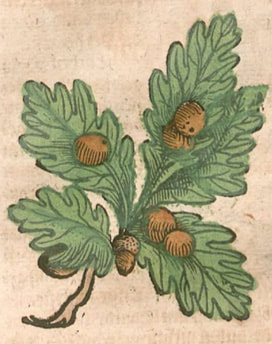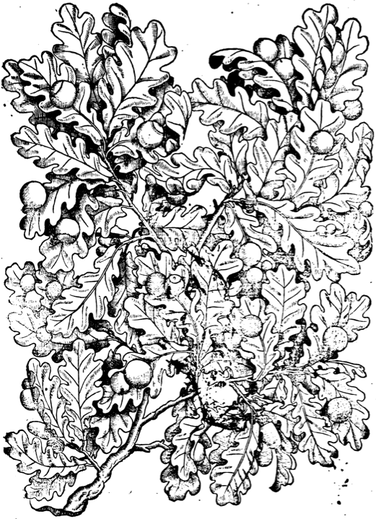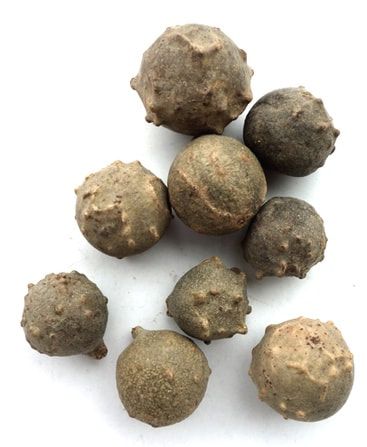Krauterbuch, Lonitzer, 1578
Quercus infectoria
(New Kreuterbuch, Matthiolus, 1563)
(New Kreuterbuch, Matthiolus, 1563)
Oak Galls (Adam, 2016)
Botanical name:
A number of Galls have been used:
1. Oak, ‘True’, European or Turkish Galls: infection of Adleria (syn. Cynips) gallae-tinctoriae on Quercus infectoria
2. Chinese or Japanese Galls: infection of Melaphis chinensis or Schlectendalia chinensis on Rhus chinensis
3. English Galls: formed by Adleria kollari on Quercus robur
4. Hungarian Galls: produced by Cynips lignicola on Quercus robur
5. Pistacia Galls: Galls obtained from Pistacia integerrima (syn. P. chinensis, Rhus integerrima) or Rhus succedanea.
These are used in Unani medicine, but Chinese galls are also recognised.
Parts used:
Gall nuts from the insects which have infected the above-named trees
Temperature & Taste:
Cold, very dry. Salty, sour, slightly sweet aftertaste.
Classifications:
2N. REPELLENTS. 2O. ASTRINGENT. 2Z. CICATRIZING
4i. UTERINE
A number of Galls have been used:
1. Oak, ‘True’, European or Turkish Galls: infection of Adleria (syn. Cynips) gallae-tinctoriae on Quercus infectoria
2. Chinese or Japanese Galls: infection of Melaphis chinensis or Schlectendalia chinensis on Rhus chinensis
3. English Galls: formed by Adleria kollari on Quercus robur
4. Hungarian Galls: produced by Cynips lignicola on Quercus robur
5. Pistacia Galls: Galls obtained from Pistacia integerrima (syn. P. chinensis, Rhus integerrima) or Rhus succedanea.
These are used in Unani medicine, but Chinese galls are also recognised.
Parts used:
Gall nuts from the insects which have infected the above-named trees
Temperature & Taste:
Cold, very dry. Salty, sour, slightly sweet aftertaste.
Classifications:
2N. REPELLENTS. 2O. ASTRINGENT. 2Z. CICATRIZING
4i. UTERINE
ADVERTISEMENT:
Uses:
1. Astringes to Stop Leakage (West, TCM, Ayurveda):
-chronic Diarrhea and Dysentery, including that with Blood
-Leukorrhea, Gonorrhea.
-Spontaneous Sweating, Night sweats.
2. Stops Bleeding (West, TCM, Ayurveda):
-chronic bleeding from the bowels with blood in the stool, bleeding Piles,
-all types of Bleeding in general. Can be used topically to stop bleeding.
-burnt or prepared Galls were preferred as a Hemostatic. (West)
3. Clears Phlegm, Stops Coughs, Consolidates the Lungs (West, TCM, Ayurveda):
-chronic Cough from Lung deficiency, evening cough due to Lung congestion;
-resolves Phlegm Nodes and Swellings
4. Clears Heat and Damp, Resists Poison:
-topically for Sores, damp Sores and Ulcers, Ringworm, and various toxic swellings.
-topically for local infections, both bacterial, viral and fungal.
-ancient physicians said it cleansed the skin if taken with Honey. (Celsus etc.)
5. Resists Poison:
-‘A general antidote to Poisons’; traditionally used for various poisons;
-in India they have been used as antidotes to the venom of Snakes and Scorpions
6. Externally:
-applied topically as a wash or powder to Sores, Toxic Swellings, Stubborn Ulcers, Fistulas, Ringworm, Skin Infections and ulcerous Dermatitis etc., where there is excess moisture.
-with Honey to whitlows, hang-nails, malformed nails, running ulcers, condylomatous swellings (Pliny)
-applied with Vinegar to Ringowrm (Avicenna)
-the powder is applied to damp-type Eczema.
-a paste is applied to Psoriasis.
-a wash to Sores in the Mouth and Nose, or a gargle for a Sore Throat.
-a decoction used as a mouth wash stops Bleeding of the Mouth.
-"Local application proves to be an effective treatment for corroded Teeth". (Avicenna)
-boiled in Vinegar, it makes a good wash for Itches.
-Burns. (TCM, West)
Dose:
500mg–2 grams
Preparation:
... available in PRO version
Correctives:
... available in PRO version
Substitutes:
... available in PRO version
500mg–2 grams
Preparation:
... available in PRO version
Correctives:
... available in PRO version
Substitutes:
... available in PRO version
Main Combinations:
1. Chronic Diarrhea:
i. Galls with ... available in PRO version
ii. Chronic Cold-type Diarrhea, Galls with ... available in PRO version
iii. Heat-type, Galls with ... available in PRO version
iv. Galls with ... available in PRO version
v. Galls with ... available in PRO version
vi. Galls with ... available in PRO version
2. Blood in the Stool, combine Galls with ... available in PRO version
3. Loose Teeth, make a decoction Galls with ... available in PRO version
4. Toothache, Galls ... available in PRO version
5. Hemorrhoids, Galls ... available in PRO version
6. Rectal prolapse, Galls ... available in PRO version
7. Scars, Galls ... available in PRO version
8. Gargle for Sore Throat, Galls with ... available in PRO version
Major Formulas:
Decoction for Sore Throat
Powder for Chronic Diarrhea (Nicholas)
Powder for Scrofula (Pharmacopoea Argentorarensis)
Powder for Scrofula (Arnold de Villa Nova)
Powder for Scrofula (Bononiense)
Powder for Phlegmatic Abscess of the Throat
Troches of Ramich (Mesue)
Electuary for Sadness and Worry
Electuarium Acharistum (Nicholas)
Pills Against Fluxes (Nicholas)
ADVERTISEMENT:
Cautions:
1. Not used for acute Cough
Main Preparations used:
1. Not used for acute Cough
Main Preparations used:
Click the Tabs above for more information on this Medicine
|
'In China these galls are probably known and used both medicinally and in dyeing since very long; they are mentioned in the herbal Pen tsaou, written in the middle of the 16th century. They also occur in Cleyer's "Specimen medicine sinicae," Frankfort, 1682, No. 225, under the name u poi cu. Kampfer also mentions a tree "Baibokf, vulgo Fusi," growing on the hills, the pinnate leaves of which he found often provided with an excrescence.,
|
they began to be imported into Europe about 1724, and are noticed by Geoffroy ' as Oreilles des Indes, but they seem to have soon disappeared from the market. Pereira directed attention to them in 1844, since which time they have formed a regular and abundant article of import both from China and Japan.' (Pharmacographia, Fluckiger & Hanbury, 1879)
|






